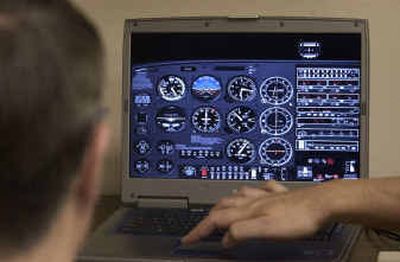Taking wing

At first glance, there’s nothing special about the counter at Felts Field Aviation. It’s the kind of wooden reception area where patrons sign in, gather information and make appointments for a myriad of reasons. But this counter is at Felts Field, and the information and appointments are for flying lessons, which makes this a life-changing transition point.
It’s where aspiring pilots meet their instructor: the teacher with the key to unlocking the sky.
“I love to fly,” said Jeff Pence, a flight instructor at Felts Field Aviation, 5829 E. Rutter Ave. “My father-in-law actually gave me a gift certificate to start flying back in 1991, and I just enjoyed it and kept improving my ratings. I wanted to build my hours (in the air), and flight instruction is just about the easiest way to do that.
“It’s been fun. It’s one of those jobs you’d love to do but you can’t afford to do full time.”
Sandy Kicha flies charters as well as spotting forest fires for the U.S. Forest Service. When she’s not doing that, she, too, teaches flying at Felts Field Aviation.
“Once the bug has bitten you, it tends to stay with you for life,” she said.
Both pilots say there’s great satisfaction in seeing pupils fly solo for the first time and earn their wings.
“The solo is something you’ll remember for the rest of your life,” Pence said. “I can guarantee you that. Ask any pilot, and they can tell you everything about their first solo. They can go on for hours about it.”
But learning to fly isn’t just about learning which control makes the aircraft do what. While pilots must know all about flight theory, meteorology and all of the Federal Aviation Administration regulations, they must learn something even more important.
“I kind of look at learning to fly as a two-part picture,” Kicha said.
“The first is that, on the other end of it, you get your pilot’s license. The other part is you get to learn an awful lot about yourself and your ability to learn and to interact with another environment.
“You experience something that a very small fraction of the population gets to experience: flying an aircraft on their own.
“Being in a position to observe those kinds of changes in other people is really very satisfying.”
The fact that people come from all walks of life to learn to fly makes the experience that much more fulfilling.
“We get people that have wanted to learn to fly their entire lives,” Kicha said. “They went to college, they got married and had kids and put it on the back burner for a long time and have come to it later in life. It’s very satisfying to see them bring that to fruition.
“That goes for the younger people, too. They’re more used to learning, and things come quickly to them — and that’s also exciting.”
Pence said his first experience as a student pilot is burned into his memory.
“It was very overwhelming,” he said. “I think I held onto the seat more than I held onto the controls.”
It was not unlike his first experience as an instructor.
“It was kind of scary,” he laughed. “I wanted to make sure I was teaching them right and that they understood what I was teaching.
“In a way it was like my first flight: Everything was above their head, and they were just amazed that they were in a little airplane.”
Learning to fly is a different experience for each student, and the length of time needed to earn a license varies. Attending ground school — classroom instruction on the many facets of flight a pilot must face — can accelerate the process.
“That’s always a good idea,” Pence said. “But you can hire an instructor to take you through the process if you don’t mind working through the books on your own.”
The lessons required to get a flying license cost a bit over $5,000. For information, call Felts Field Aviation, 535-9011.
What’s the most difficult part of the process for most students?
“It’s either the landing or the radio work,” Pence said. “Most students struggle with the radio. It’s learning all the terminology.
“Felts is probably one of the better places to learn to fly. You still get the radio experience, but yet it doesn’t take you forever to get out to the practice area to do the maneuvers and stuff.
“You don’t spend a lot of your time on the ground with the engine running waiting for other aircraft. Plus it’s pretty easy getting in and out of Felts.”
No matter how a student learns, Kicha explained, there’s satisfaction for both the student and the instructor in the end.
“It’s very satisfying as an instructor, but even more so I get a sense of enjoyment seeing that person get that sense of accomplishment,” she said. “I know they’re going to get there; it’s just a matter of when.
“It’s exciting in that maybe you find a different way to make that person understand what they needed to know — it took four or five ways of explaining it before that person finally got it. As instructor you feel — oh good, I finally figured it out.”